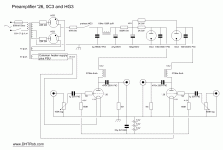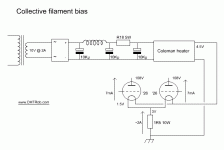Unfortunately, the OPT used in the schematic is not available, however possible substitute are assumed to be available, the following is catalogs for your references.
You can see the price list for Noguchi FM-20K600CT, FM24K-600CT and Andix Audio RT20K600
ttp://noguchi-trans.co.jp/index.php?main_page=index&cPath=40
ttp://www.andix.co.jp/
the noguchi 20K sounds good for the task , do you know a japanese seller with a international website for ordering?
It's necessary to connect the output RCA gnd to gnd?
Please help
Grounding the output side of the line output transformer isn't necessary... but I always do it.Please help
It's matter of taste, which version is better.
Your question is unclear to me and probably to others, too.Please help
The connection marked red is the secondary winding of the output transformer... ?
Grounding the output side of the line output transformer isn't necessary... but I always do it.
It's matter of taste, which version is better.
I don't ground preamp OPT secondary - that avoids ground loops between devices.
Your question is unclear to me and probably to others, too.
The connection marked red is the secondary winding of the output transformer... ?
Yes is where I connect the output RCA gnd, the question is: I need to connect also to GND?
the noguchi 20K sounds good for the task , do you know a japanese seller with a international website for ordering?
I telephoned to Noguchi, but they do not have a sales department for oversees.
I am sorry to say I do not know available channel.
I telephoned to Noguchi, but they do not have a sales department for oversees.
I am sorry to say I do not know available channel.
thanks for your time
Collective filament supply
Hi,
Some experimenting: Just modded my preamp.. Why? No clue, must be some kind of curiousness..
The preamp I am using at the moment has both filaments in series, fed by one (Coleman) supply tied to ground. Valves are biased using a battery, thus using an input capacitor (see attached diagram). Sounds great!
A few weeks ago I had a chat discussing the possibility of putting both filaments in parallel and use filament bias for both valves with one resistor. (see attached diagram). Since we need now only half of the value filament bias resistor (twice the current), this might be the same as when using one battery to bias both valves. One thing left is possibility for crosstalk left to right channel and vv)..
Today I tested the preamp built this way and could not see any crosstalk on the scope with one valves' grid shorted to ground and the other with 5 Volt RMS signal on the grid.. Also no crosstalk when grid is not shorted to ground..
This works like a charm, sounds perfect and is dead-silent when not playing..
Thought I'd share this..
Hi,
Some experimenting: Just modded my preamp.. Why? No clue, must be some kind of curiousness..
The preamp I am using at the moment has both filaments in series, fed by one (Coleman) supply tied to ground. Valves are biased using a battery, thus using an input capacitor (see attached diagram). Sounds great!
A few weeks ago I had a chat discussing the possibility of putting both filaments in parallel and use filament bias for both valves with one resistor. (see attached diagram). Since we need now only half of the value filament bias resistor (twice the current), this might be the same as when using one battery to bias both valves. One thing left is possibility for crosstalk left to right channel and vv)..
Today I tested the preamp built this way and could not see any crosstalk on the scope with one valves' grid shorted to ground and the other with 5 Volt RMS signal on the grid.. Also no crosstalk when grid is not shorted to ground..
This works like a charm, sounds perfect and is dead-silent when not playing..
Thought I'd share this..
Attachments
Hi Rob,
My original 26 prototype (I am still using it) uses the same approach to filament heating (no ccs) - you will note due to filament polarity that the operating points of the two 26s will be slightly different. I use fixed bias and just adjust the bias pots to compensate. (I've used and like battery bias too)
My original 26 prototype (I am still using it) uses the same approach to filament heating (no ccs) - you will note due to filament polarity that the operating points of the two 26s will be slightly different. I use fixed bias and just adjust the bias pots to compensate. (I've used and like battery bias too)
Hi Kevinkr.
Yes, it does sound great.
I think you refer to using filaments in series? Correct?
In this preamp I stabilize the 26's using a 0C3 per channel, so approx 100 Volts on the plate and filament bias set for both channels with ONE resistor using ONE filament supply..
Only one drawback: If one filament breaks, the other one will go as well because of getting twice the current.. Maybe some strategically placed fuses will take away that..
Yes, it does sound great.
I think you refer to using filaments in series? Correct?
In this preamp I stabilize the 26's using a 0C3 per channel, so approx 100 Volts on the plate and filament bias set for both channels with ONE resistor using ONE filament supply..
Only one drawback: If one filament breaks, the other one will go as well because of getting twice the current.. Maybe some strategically placed fuses will take away that..
Actually since they are in series if one filament breaks the string goes open and no current flows. Mine have been in series for 13yrs and I have not had a single filament failure. (Inrush current is limited to a couple of amps.)
Measure the plate current using the dcr across your chokes and you may note a slight difference in operating point due to filament polarity if the tubes were closely matched in the first place.
Measure the plate current using the dcr across your chokes and you may note a slight difference in operating point due to filament polarity if the tubes were closely matched in the first place.
Yes, I am aware of the different operating points when one filament is fed negative and the other positive (in series).. I corrected that the same way you did however there was not much difference between several specimens 26.. guess it was good steady production those days..
Thanks..
Thanks..
YHPM = ???
YHPM = you have private message
- Home
- Amplifiers
- Tubes / Valves
- #26 pre amp

